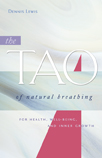A Taoist approach to mindful breathing
 The great Taoist philosopher Tchang Zu tells us that True man breathes with his heels, while the mass of men breathe with their throats.
Never mind the heels, you’re probably doing OK if you manage to take breath awareness as far down as your perineum, but breathing mostly with your chest,
and with very little awareness of what’s really happening, is not a recipe for health and happiness.
In this 200 pages book, Dennis Lewis, a Qi Gong master and long-time-student of Taoism, skilfully takes us through the Taoist approach to mindful breathing. The parallels with the Sati yoga approach are striking. When he introduces us to what Gurudjeff calls “Presence”, this dimension in ourselves of inner quiet and inner clarity, as a both a precondition and a result of practising with the breath, his words echoes the Buddha’s on mindfulness of breathing.
Indeed, most of the practices presented in this book are strikingly similar to yoga or Buddhist practices.
The chapter on “whole body breath” sheds light on the third practice of the Anapanasati Suta , breathing in and out sensitive to the entire body, and is a good introduction to this essential practice.
While reading the chapter on the “spacious breath”, I found myself musing about the parallels between the “three breathing spaces” and the three bandhas in common use in pranayama, and most asana practitioners will find the encouragement to practice this type of breathing while under stress very useful. And what but the “smiling breath” was Thich Nhat Hanh talking about when he said “Breathing in, I calm body and mind, breathing out I smile“?
Most of the Specialized breathing practices listed in Appendix 1 have yogic equivalent, and I personally found the Taoist version of Ujayi breathing, called Reversed abdominal breathing, so interesting that I have included it in my regular practice.
Dennis remarks on the psychological obstacles to authentic breathing and the psychological and the emotional dimensions of breathing practices are also very insightful.
This book is full of sound advice which asana, pranayama and meditation practitioners of all levels will find most useful. Highly recommended.
The great Taoist philosopher Tchang Zu tells us that True man breathes with his heels, while the mass of men breathe with their throats.
Never mind the heels, you’re probably doing OK if you manage to take breath awareness as far down as your perineum, but breathing mostly with your chest,
and with very little awareness of what’s really happening, is not a recipe for health and happiness.
In this 200 pages book, Dennis Lewis, a Qi Gong master and long-time-student of Taoism, skilfully takes us through the Taoist approach to mindful breathing. The parallels with the Sati yoga approach are striking. When he introduces us to what Gurudjeff calls “Presence”, this dimension in ourselves of inner quiet and inner clarity, as a both a precondition and a result of practising with the breath, his words echoes the Buddha’s on mindfulness of breathing.
Indeed, most of the practices presented in this book are strikingly similar to yoga or Buddhist practices.
The chapter on “whole body breath” sheds light on the third practice of the Anapanasati Suta , breathing in and out sensitive to the entire body, and is a good introduction to this essential practice.
While reading the chapter on the “spacious breath”, I found myself musing about the parallels between the “three breathing spaces” and the three bandhas in common use in pranayama, and most asana practitioners will find the encouragement to practice this type of breathing while under stress very useful. And what but the “smiling breath” was Thich Nhat Hanh talking about when he said “Breathing in, I calm body and mind, breathing out I smile“?
Most of the Specialized breathing practices listed in Appendix 1 have yogic equivalent, and I personally found the Taoist version of Ujayi breathing, called Reversed abdominal breathing, so interesting that I have included it in my regular practice.
Dennis remarks on the psychological obstacles to authentic breathing and the psychological and the emotional dimensions of breathing practices are also very insightful.
This book is full of sound advice which asana, pranayama and meditation practitioners of all levels will find most useful. Highly recommended.

